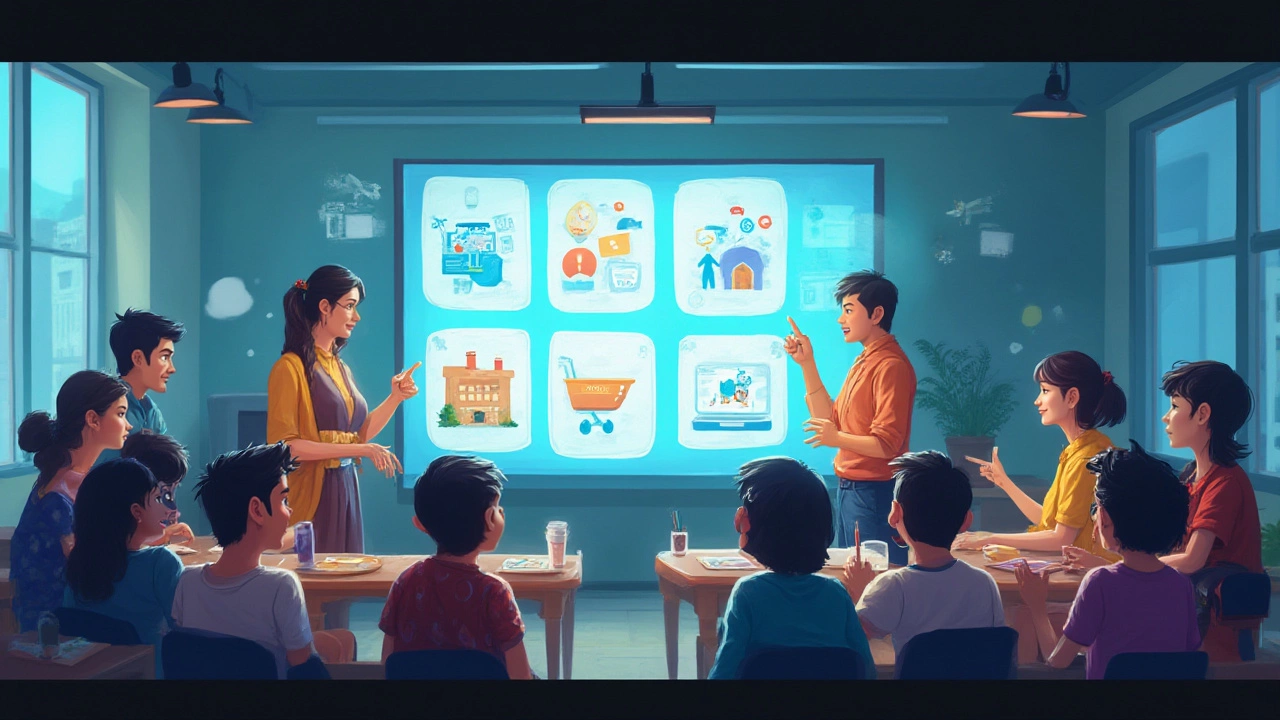Imagine a world where nearly everything you do—work, shop, learn, chat—happens online. That’s not futuristic anymore, it’s just how life rolls in Manchester and pretty much everywhere else. But with so much happening on the web, “online platform” can mean anything—from a social media giant to an app where you book your dog’s grooming. The tricky part? Not all online platforms are the same. They fall into four main types, and knowing these makes it ten times easier to pick tools that make your days smoother and more productive. Ready to sort your way through the digital jungle?
Social Platforms: Where Connections Happen
First up are the social platforms. You probably think of Facebook, Instagram, WhatsApp, Snapchat, and TikTok. But there’s more depth here than “scroll, like, repeat.” At their hearts, social platforms are digital spaces for making connections—friends, family, colleagues, or complete strangers. Besides chatting and sharing, these platforms have seriously re-shaped activism, global news, and even businesses. Did you know more than 4.8 billion people use social media as of January 2025? That’s 59% of the world’s population. No other communication channel even comes close.
But it’s not all about memes and viral dances. Businesses run entire marketing campaigns through social media. Organisations use them for customer support (ever tweeted at a brand and got a reply?). Personal brands and small shop owners use Instagram shopping, turning followers into loyal customers. Some universities now run private Facebook groups for classes or alumni. These platforms have even become key drivers in politics and social movements—hashtags like #BlackLivesMatter showed how a tweet can spark global waves. The point: social platforms are sticky, complex, and powerful. Like them or not, they’re now a crucial toolkit for modern living.
Just remember, attention is currency here. Platforms are designed to keep you hooked, using algorithms that serve up exactly what you want (or hate) to see. A handy tip? Review your privacy settings regularly, stay alert for scams, and limit doom-scrolling. And don’t underestimate LinkedIn—less flashy, but if you’re looking for jobs or networking in your field, it’s pure gold.
Educational Platforms: Learning Without Borders
If you went to school in the ‘90s or early 2000s, the chalk-and-talk classroom felt unavoidable. Fast forward to 2025, and educational platforms have rewritten the rules. You’ll find academic libraries, short courses, coding bootcamps, even entire university degrees—accessible from anywhere with WiFi. Here’s a fun fact: the global e-learning market is now worth around $400 billion and keeps growing every year. A lot of teachers and students discovered platforms like Coursera, Udemy, or Khan Academy during the pandemic, and stuck with them for their flexibility.
But education platforms aren’t one-size-fits-all. Some are all about structure, with fixed start/end dates and strict assessment timetables—think Open University. Others, like edX or Skillshare, let you learn at your own pace. Then you have platforms built for younger learners: BBC Bitesize (yes, still relevant in 2025), Duolingo for language geeks, or White Hat Jr. for wannabe teen coders. The best part? Many are free or cost a fraction of traditional schooling.
There are huge forums—like Stack Overflow—where coders answer each other’s questions, making it a community as much as a learning tool. Some sites mix live lessons with recorded material. Real classrooms have moved online too; Microsoft Teams and Google Classroom became new chalkboards. If you’re teaching, explore how to create interactive quizzes, polls, or forums to boost engagement. For learners, set aside distraction-free time to tackle content, and try mobile apps to learn on commutes. And always check for official certificates if you plan to add new skills to your CV. One more tip: don’t ignore niche platforms. For weirdly specific topics (bird watching, Italian cooking, advanced Excel), there’s likely an online community waiting for you.

Commercial Platforms: Shopping, Banking & Beyond
Remember when shopping meant schlepping to the city centre or queueing at the bank just to check your balance? Enter commercial platforms—a broad term for all the sites and apps that let you buy, sell, pay and trade online. The biggest names are probably Amazon, eBay, Shopify, and banking apps from every major high street bank. In 2024, UK consumers spent over £120 billion on e-commerce alone. It’s not just retail; UberEats, Just Eat, and Deliveroo reshaped how we order dinner, and platforms like Airbnb turned spare rooms into hotel suites.
What makes a commercial platform? There are two flavours: marketplaces (Amazon, Etsy, eBay) where anyone can sell or buy, and single-brand shops (Nike.com, Apple) focused on their own products. Then you have service-based platforms—banks, insurance, travel booking, even apps for wellness or fitness. As cash becomes less common, even corner shops are signing up to online point-of-sale systems.
Safety is huge on these platforms. Top sites use encryption and secure payment methods, adding extra protections like Two-Factor Authentication. Be wary of scam shops that look polished but disappear after taking your card info. Always read real user reviews and look for signals like “Verified Seller” or customer protection terms. Many platforms now offer same-day delivery and user-friendly returns. And don’t forget: online subscriptions (music, streaming, gym classes) are their own sub-niche here. Keep an eye on ‘free trials’ that quietly start billing your card, and set reminders to cancel anything you don’t use. A trick: use digital wallets (Apple Pay, Google Pay) for extra layers of privacy, and monitor monthly spending with tracking apps. If you’re a business, embrace e-commerce early—platforms like Shopify make building an online store nearly as easy as posting on Instagram.
Service & Collaboration Platforms: Working Together Remotely
Finally, we hit the platforms that let teams work together—whether they’re in different cities or just the other side of Manchester. Remote working exploded since 2020, making these tools critical for daily life. Think Zoom, Microsoft Teams, Slack, and Google Workspace. But collaboration platforms aren’t just about office jobs. Discord has millions of creative communities for artists, gamers, and hobbyists. Trello and Asana organise your personal tasks just as well as a company’s project list.
Here’s something wild: in 2024, one in three UK workers reported using at least three different collaboration tools every week. These platforms support everything from group chats and video meetings, to file storage and shared whiteboards. Small businesses hold team calls on Zoom; global firms coordinate cross-border projects with Notion or Monday.com. Even schools and charities use these platforms to run events and clubs. Real-time collaboration means less faffing around with endless emails or lost documents—it’s all live, instant, and in the cloud.
To get the most out of these platforms, master the basics but also dig into the extras: shortcuts, keyboard commands, real-time polls, breakout rooms, or integrations with other apps. Always watch out for “notification overload” (hello, hundreds of unread Slack pings), and schedule downtime to avoid burnout. And yes, it’s perfectly okay to turn off cameras or mute yourself on big calls. Most platforms offer mobile apps too, so you can join meetings or update project lists from anywhere. If confidentiality matters, look for end-to-end encryption and strong admin controls.
| Platform Type | Popular Examples | Main Features | Typical Users |
|---|---|---|---|
| Social | Facebook, Instagram, LinkedIn, TikTok | Connecting, sharing, messaging, communities | Everyone, influencers, businesses |
| Educational | Coursera, Khan Academy, Duolingo | Courses, videos, interactive quizzes, forums | Students, teachers, lifelong learners |
| Commercial | Amazon, eBay, Shopify, Airbnb | Buy/sell goods and services, secure payments | Shoppers, sellers, small businesses |
| Collaboration | Zoom, Teams, Slack, Google Workspace | Remote meetings, project management, file sharing | Remote workers, teams, community groups |
So, when someone asks “what are the 4 online platforms?”, you’ve got the real, practical rundown. From connecting with mates to learning Spanish, shopping for trainers, or launching a full remote company, each platform type has its own promise—and a few quirks. Mastering these can save time, boost skills, and give you the edge, whether you’re hustling in the city or lounging in your PJs at home.





